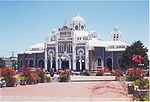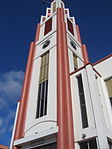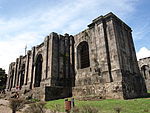Cartago
| Cartago | |
|---|---|
|
Coordinates: 9 ° 51 ′ N , 83 ° 55 ′ W
Cartago on the map of Cartago Province
|
|
| Basic data | |
| Country | Costa Rica |
| province | Cartago |
| City foundation | 1563 |
| Residents | 147,898 |
| City insignia | |
| Detailed data | |
| surface | 44.62 km 2 |
| Population density | 7,546 inhabitants / km 2 |
| height | 1432 m |
| Time zone | UTC −6 |
| City Presidency | Lic. Rolando Rodríguez Brenes |
| Website | |
| View of Cartago | |
Cartago is a city in the Central American state of Costa Rica and the capital of the province of the same name . The population in 2011 was 147,898.
It is located about 22 km east of the capital San José at an altitude of about 1432 m above sea level at the southern foot of the Irazú volcano .
history
The Spanish conquistador Juan Vázquez de Coronado founded the city of Cartago in 1563 as the first Spanish settlement in what is now Costa Rica. From the founding to the independence of Costa Rica in 1821 it was the seat of the Spanish governor. The capital initially changed several times between Cartago, San José and Alajuela , but was finally relocated to the then small village of San José in 1823 by the first elected head of state, Juan Mora Fernández .
In 1723 the city was destroyed by an eruption of the Irazú. Major earthquakes in 1822, 1841 and 1910 caused severe damage. Another eruption of the volcano in 1963 also caused severe damage to the city.
In 1842 the Colegio San Luis Gonzaga was founded, the oldest higher education institution in the country.
In 1907, the city became the seat of the newly established Central American Court of Justice , but this was moved to San José at the beginning of 1911 due to the earthquake of 1910.
Every year on August 2nd, hundreds of thousands of pilgrims flock to the most important church in the country, the Basílica de Nuestra Señora de Los Ángeles . A statue of the Black Madonna ( La Negrita ) is kept in the church and is said to have healing powers.
In 1971 the technical university " Instituto Tecnológico de Costa Rica " was opened in Cartago , which today is one of the most prestigious institutions in Central America.
In 2005 the Roman Catholic Diocese of Cartago was established in the city and the Church of Nuestra Señora de El Carmen was elevated to the status of a cathedral .
City center attractions
- Las Ruinas de la Parroquia de Santiago Apóstol : In the park of the city is the never completed Church of the Apostle James (Santiago) , which is one of the national cultural monuments of Costa Rica. The local population calls it " Las Ruinas ". A previous building from 1575 was destroyed by the earthquakes in 1630 and 1656, which is why construction of the church began in 1656, which was completed and consecrated in 1662. A prayer chapel and a funeral chapel were part of the new construction of this church. Further earthquakes in 1718 and 1756 caused serious damage to the structure, which could, however, be repaired. On September 2, 1841, the earth shook again in Cartago. In this earthquake, known as San Antolín , the church was so badly damaged that it had to give way to a new building. In 1870, under the direction of Luis Llach and the German-born architect Francisco Kurtz, construction began in the Romanesque style. Work was interrupted shortly after the start of construction and only resumed 30 years later between 1903 and 1904. The final end for the church was the Santa Monica earthquake in 1910. After that it was decided not to rebuild the church and to build a new church, the Basilica Nuestra Señora de los Ángeles, a little further east. The ruins of the Santiago de Compostela Church were declared a Cultural Monument of Costa Rica on August 25, 1982 by Decree No. 13799-C.
- Nuestra Señora de los Ángeles Basilica , pilgrimage church
- "La Negrita", the black Madonna of Costa Rica. It is located in the Nuestra Señora de los Ángeles Basilica from September to August 2, and then for a month in the Cathedral of Costa Rica.
- Cathedral of Our Lady of El Carmen , Cathedral of the Diocese of Cartago built 1954-1960 in the Art Deco style.
- Traditional house of the Costa Rican President Jesús Jiménez Zamora (1823–1897), built in the style typical of the country and completely preserved.
- Colegio San Luis Gonzaga, Costa Rica's oldest secondary school in neoclassical style.
- City Museum - Museo Municipal de Cartago, in the city's former prison
| Cartago | ||||||||||||||||||||||||||||||||||||||||||||||||
|---|---|---|---|---|---|---|---|---|---|---|---|---|---|---|---|---|---|---|---|---|---|---|---|---|---|---|---|---|---|---|---|---|---|---|---|---|---|---|---|---|---|---|---|---|---|---|---|---|
| Climate diagram | ||||||||||||||||||||||||||||||||||||||||||||||||
| ||||||||||||||||||||||||||||||||||||||||||||||||
Sports
The Club Sport Cartaginés with the establishment in 1906 of one of the oldest and most traditional football clubs in Costa Rica.
sons and daughters of the town
- Joaquín de Oreamuno y Muñoz de la Trinidad (1755–1827), head of state of Costa Rica
- Pedro José de Alvarado y Baeza (1767–1839), priest and President of Costa Rica
- José Santos Lombardo y Alvarado (1775–1829), President of Costa Rica
- José Rafael de Gallegos y Alvarado (1784–1850), head of state of Costa Rica
- Francisco Gómez de Altamirano y de Elizondo (1796–1838), Jefe Supremo of the Province of El Salvador in the Central American Confederation
- Braulio Evaristo Carrillo Colina (1800–1845), head of state of Costa Rica
- Joaquín Eufrasio Guzmán (1801–1875), President of El Salvador
- Francisco María Oreamuno Bonilla (1801-1856), President of Costa Rica
- Evaristo Carazo Aranda (1822-1889), politician
- Jesús Jiménez Zamora (1823–1897), President of Costa Rica
- Aniceto Esquivel Sáenz (1824–1898), President of Costa Rica
- Guillermo Rojas y Arrieta (1855–1933), Archbishop of Panama
- Francisco Aguilar Barquero (1857–1924), President of Costa Rica
- Ricardo Jiménez Oreamuno (1859–1945), President of Costa Rica
- Alberto Oreamuno Flores (1905–1980), professor of medicine and politician
- Antonio Troyo Calderón (1923–2015), Roman Catholic clergyman
- Rodrigo Carazo Odio (1926–2009), politician
- Carlos Johnson (born 1984), football player
- David Jiménez (born 1992), boxer
Web links
- City website (Spanish)
proof
- ↑ Instituto nacional de estadística y censos (INEC) - Censos 2011 , accessed on September 20, 2017
- ↑ Jubilee of Mercy , accessed September 20, 2017








